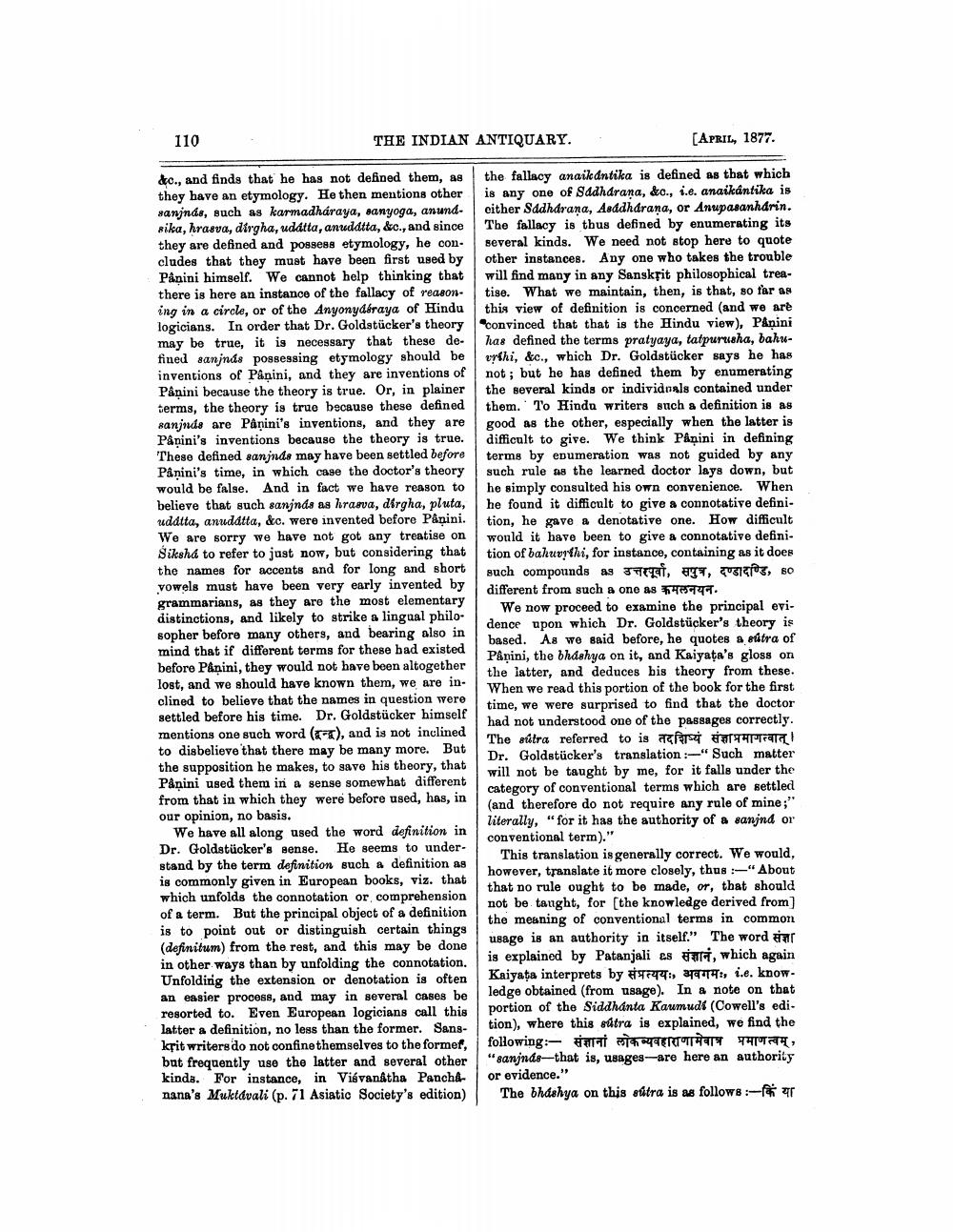________________
110
THE INDIAN ANTIQUARY.
[APRIL, 1877.
the fallacy anaikantika is defined as that which is any one of Sádhárana, &c., i.e. anaikântika is either Sadhdrana, Aeddhdrana, or Anupasanhárin. The fallacy is thus defined by enumerating its several kinds. We need not stop here to quote other instances. Any one who takes the trouble will find many in any Sanskrit philosophical treatise. What we maintain, then, is that, so far as this view of definition is concerned (and we are convinced that that is the Hindu view), Pânini has defined the terms pratyaya, tatpurusha, bahuvrthi, &c., which Dr. Goldstücker says he has not; but he has defined them by enumerating the several kinds or individuals contained under them. To Hindu writers such a definition is as good as the other, especially when the latter is difficult to give. We think Panini in defining terms by enumeration was not guided by any such rule as the learned doctor lays down, but he simply consulted his own convenience. When he found it difficult to give a connotative definition, he gave a denotative one. How difficult I would it have been to give a connotative definition of bahuvythi, for instance, containing as it does such compounds as उत्तरपूर्वा, सपुत्र, दण्डादण्डि, BO different from such a one as कमलनयन.
We now proceed to examine the principal evidence upon which Dr. Goldstücker's theory is based. As we said before, he quotes a sútra of Panini, the bhashya on it, and Kaiyaṭa's gloss on the latter, and deduces his theory from these. When we read this portion of the book for the first time, we were surprised to find that the doctor had not understood one of the passages correctly. The sutra referred to is तदशिष्यं संज्ञाप्रमाणत्वात् । Dr. Goldstücker's translation:-" Such matter will not be taught by me, for it falls under the category of conventional terms which are settled (and therefore do not require any rule of mine;" literally, "for it has the authority of a sanjnd or conventional term)."
&c., and finds that he has not defined them, as they have an etymology. He then mentions other sanjnds, such as karmadháraya, sanyoga, anundsika, hrasva, dirgha, udátta, anuddtta, &c., and since they are defined and possess etymology, he conIcludes that they must have been first used by Pânini himself. We cannot help thinking that there is here an instance of the fallacy of reasoning in a circle, or of the Anyonyáéraya of Hindu logicians. In order that Dr. Goldstücker's theory may be true, it is necessary that these defined sanjnás possessing etymology should be inventions of Pânini, and they are inventions of Panini because the theory is true. Or, in plainer terms, the theory is true because these defined sanjnds are Pânini's inventions, and they are Pânini's inventions because the theory is true. These defined sanjnds may have been settled before Panini's time, in which case the doctor's theory would be false. And in fact we have reason to believe that such sanjnds as hrasva, dirgha, pluta, udátta, anudátta, &c. were invented before Pânini. We are sorry we have not got any treatise on Sikshá to refer to just now, but considering that the names for accents and for long and short vowels must have been very early invented by grammarians, as they are the most elementary distinctions, and likely to strike a lingual philosopher before many others, and bearing also in mind that if different terms for these had existed before Panini, they would not have been altogether lost, and we should have known them, we are inclined to believe that the names in question were settled before his time. Dr. Goldstücker himself mentions one such word (), and is not inclined to disbelieve that there may be many more. But the supposition he makes, to save his theory, that Panini used them in a sense somewhat different from that in which they were before used, has, in our opinion, no basis.
We have all along used the word definition in Dr. Goldstücker's sense. He seems to understand by the term definition such a definition as is commonly given in European books, viz. that which unfolds the connotation or comprehension of a term. But the principal object of a definition is to point out or distinguish certain things (definitum) from the rest, and this may be done in other ways than by unfolding the connotation. Unfolding the extension or denotation is often an easier process, and may in several cases be resorted to. Even European logicians call this latter a definition, no less than the former. Sanskrit writers do not confine themselves to the former, but frequently use the latter and several other kinda. For instance, in Viśvanatha Panchâ nana's Muktávali (p. 71 Asiatic Society's edition)
This translation is generally correct. We would, however, translate it more closely, thus :-"About that no rule ought to be made, or, that should not be taught, for [the knowledge derived from] the meaning of conventional terms in common usage is an authority in itself." The word l is explained by Patanjali es, which again Kaiyata interprets by संप्रत्ययः, अवगमः, ie knowledge obtained (from usage). In a note on that portion of the Siddhánta Kaumudi (Cowell's edition), where this sutra is explained, we find the following:"sanjnds-that is, usages-are here an authority or evidence."
The bhashya on this sûtra is as follows:-fr




